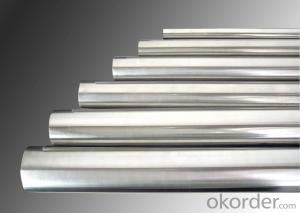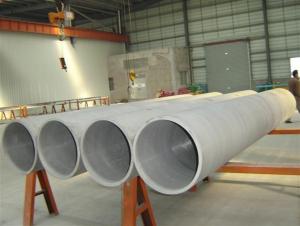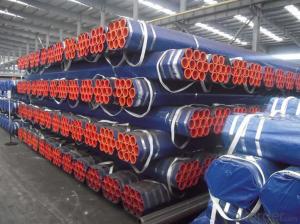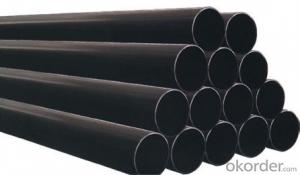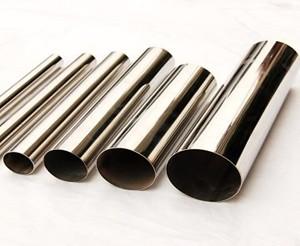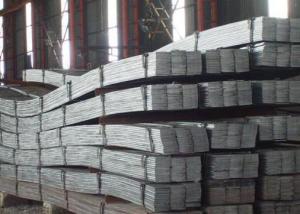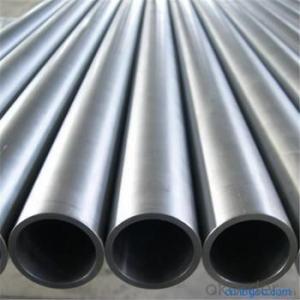API Galvanized Stainless Steel Pipe With 2 Plastic Pipe Caps
- Loading Port:
- Tianjin
- Payment Terms:
- TT OR LC
- Min Order Qty:
- 35 m.t.
- Supply Capability:
- 5000 m.t./month
OKorder Service Pledge
OKorder Financial Service
You Might Also Like
Specification
API Galvanized Stainless Steel Pipe With 2 Plastic Pipe Caps
1.Structure of Stainless Steel Pipe :
Seamless pipe is formed by drawing a solid billet over a piercing rod to create the hollow shell. As the manufacturing process does not include any welding, seamless pipes are perceived to be stronger and more reliable. Historically seamless pipe was regarded as withstanding pressure better than other types, and was often more easily available than welded pipe.
2.Main Features of the Stainless Steel Pipe :
• High manufacturing accuracy
• High strength
• Small inertia resistance
• Strong heat dissipation ability
• Good visual effect
• Reasonable price
3.Stainless Steel Pipe Specification:
Standard | GB, DIN, ASTM ASTM A106-2006, ASTM A53-2007 |
Grade | 10#-45#, 16Mn 10#, 20#, 45#, 16Mn |
Thickness | 8 - 33 mm |
Section Shape | Round |
Outer Diameter | 133 - 219 mm |
Place of Origin | Shandong, China (Mainland) |
Secondary Or Not | Non-secondary |
Application | Hydraulic Pipe |
Technique | Cold Drawn |
Certification | API |
Surface Treatment | factory state or painted black |
Special Pipe | API Pipe |
Alloy Or Not | Non-alloy |
Length | 5-12M |
Outer Diameter | 21.3-610mm |
Grade | 20#, 45#, Q345, API J55, API K55, API L80, API N80, API P110, A53B |
Standard | ASME, ASTM |
1) Material:20#(ASTM A 106/A53 GRB.API5LGRB,GB),45#,16Mn,10#.
2) Specification range:OD:21.3-610mm,WT:6-70mm,length:6-12m or according to the requirement of clients.
3) Excutive standards:GB,ASME API5L.ASTM A 106/A53,Despite of the above standards,we can also supply seamless steel pipe with standard of DIN,JIS,and so on,and also develop new products according to the requirements of our clients!
4) Surface:black lacquered,varnish coating or galvanized.
5) Ends:Beveled or square cut,plastic capped,painted.
6) Packing:bundles wrapped with strong steel strip,seaworthy packing.
4. Packing and Delivery:
Packaging Details: | seaworthy package,bundles wrapped with strong steel strip |
Delivery Detail: | 50-60days after received 30%TT or Original LC |
5. FAQ of Stainless Steel Pipe
A. How is the quality of your products?
Our products are manufactured strictly according to national and internaional standard, and we take a test on every pipe before delivered out. If you want see our quality certifications and all kinds of testing report, please just ask us for it.
Guaranteed: If products’ quality don’t accord to discription as we give or the promise before you place order, we promise 100% refund.we are factory and be able to give you lowest price below market one, and we have a policy that “ for saving time and absolutely honest business attitude, we quote as lowest as possible for any customer, and discount can be given according to quantity”,if you like bargain and factory price is not low enough as you think, just don’t waste your time.Please trust the quotation we would give you, it is professional one.
B. Why should you chose us?
Chose happens because of quality, then price, We can give you both.Additionally, we can also offer professional products inquiry, products knowledge train(for agents), smooth goods delivery, exellent customer solution proposals.Our service formula: good quality+good price+good service=customer’s trust
SGS test is available, customer inspection before shipping is welcome, third party inspection is no problem.
Any question, pls feel free to contact us !
6.Stainless Steel Pipe Images:

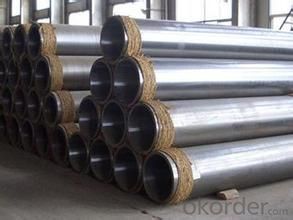
7. Company Information:
CNBM International Corporation (CNBM International) is the most important trading platform of CNBM Group Corporation, a state-owned company under the direct supervision of State-owned Assets Supervision and Administration Commission of the State Council.
Since 2004, the trading volume of CNBM International has been doubled in 5 successive years owing to the support of superior corporations and effort of all staff. Meanwhile, we have established strategic partnerships with hundreds of domestic manufacturers and sound business relations with clients from over 120 countries. Currently, we have wholly-owned overseas subsidiaries and branches in 5 countries with a view to realize localization, which also represents an essential progress in our globalization target.

In line with the business, CNBM International launched E-business platform Okorder.com.Our goal is to transform CNBM International into the global leading brand in building materials industry within 3 to 5 years through innovation and reform, by strengthening the overall management of supply chain, developing and cultivating both domestic and overseas market, improving the procedure and information system, enhancing the ability to organize resources and to provide value-added services under a professional team and a learning organization.
- Q: Can stainless steel pipes be used for firefighting systems?
- Yes, stainless steel pipes can be used for firefighting systems. Stainless steel is a durable and corrosion-resistant material, making it suitable for such applications where durability and resistance to heat and pressure are required.
- Q: Can stainless steel pipes be stress relieved?
- Yes, stainless steel pipes can be stress relieved. Stress relieving is a heat treatment process that helps to reduce residual stresses in the material, improving its mechanical properties and reducing the risk of cracking or distortion. This process can be applied to stainless steel pipes to enhance their performance and durability.
- Q: How do stainless steel pipes compare to titanium pipes?
- Stainless steel pipes and titanium pipes have their own unique characteristics and are used in various applications depending on specific requirements. In terms of strength, titanium pipes are generally stronger than stainless steel pipes. Titanium has a high strength-to-weight ratio, making it ideal for applications that require lightweight but strong materials. Stainless steel, on the other hand, is known for its excellent tensile strength and durability but is relatively heavier compared to titanium. When it comes to corrosion resistance, both stainless steel and titanium pipes are highly resistant to corrosion. However, titanium pipes offer superior corrosion resistance, especially in aggressive environments such as seawater or chemical processing applications. Stainless steel pipes also have good corrosion resistance, but may require additional coatings or treatments to enhance their resistance in certain conditions. Another aspect to consider is the temperature resistance. Titanium pipes can withstand high temperatures without losing their strength or structural integrity, making them suitable for high-temperature applications such as aerospace or power generation industries. Stainless steel pipes also exhibit good heat resistance, but their performance may vary depending on the specific grade of stainless steel and the temperature range involved. Cost is an important factor to consider as well. Stainless steel pipes are generally more cost-effective compared to titanium pipes. Titanium is a more expensive material due to its scarcity, difficult fabrication process, and higher production costs. Therefore, if cost is a significant consideration, stainless steel pipes might be a more viable option. In summary, stainless steel pipes and titanium pipes have their own advantages and are suitable for different applications. Titanium pipes offer superior strength, corrosion resistance, and heat resistance, but come at a higher cost. Stainless steel pipes provide good strength, corrosion resistance, and cost-effectiveness. Ultimately, the choice between the two will depend on the specific requirements, budget, and intended application of the pipes.
- Q: What is the welding procedure for stainless steel pipes?
- To achieve a strong and durable joint, stainless steel pipes undergo a specific welding procedure. Typically, the process entails several crucial steps. To begin, it is essential to choose the appropriate welding technique for stainless steel, which is often Tungsten Inert Gas (TIG) welding due to its ability to produce precise and clean welds. Before commencing the welding process, it is necessary to thoroughly clean the stainless steel pipes to eliminate any contaminants like dirt, grease, or oxidation. This can be accomplished using either a degreasing agent or a stainless steel wire brush. Following the cleaning process, the pipes must be aligned and fitted together correctly. It is crucial to ensure that the gap between the pipes remains consistent and even throughout the joint. This can be achieved by temporarily securing the pipes in place using clamps or tack welding. Once the pipes are properly aligned, the TIG welding process can commence. This involves using a TIG torch to create an electric arc between a tungsten electrode and the stainless steel pipes. The intense heat generated by the arc melts the edges of the pipes, creating a fusion between the base metal and the filler material. During the welding process, it is vital to maintain a stable arc length and control the welding speed to achieve a uniform weld bead. Regulating the heat input and controlling the welding parameters can be accomplished by utilizing a foot pedal or a remote control. Throughout the welding process, it is important to safeguard the weld area from contamination. This can be achieved by using shielding gas, such as argon, to establish an inert atmosphere around the weld zone. The shielding gas prevents the weld area from reacting with oxygen and other atmospheric elements that could result in weld defects. Upon completing the welding, it is advisable to perform post-weld cleaning and inspection. This involves removing any slag or spatter that may have formed during the welding process and visually examining the weld for any defects like cracks or discontinuities. In summary, the welding procedure for stainless steel pipes involves cleaning the pipes, aligning and fitting them together, TIG welding with the appropriate arc length and welding speed, shielding the weld area with inert gas, and conducting post-weld cleaning and inspection. By following these steps, a dependable and sturdy weld joint can be achieved for stainless steel pipes.
- Q: Are stainless steel pipes suitable for marine applications?
- Stainless steel pipes are perfectly suited for marine applications due to their exceptional corrosion resistance. The stainless steel material is renowned for its ability to withstand harsh conditions in marine environments, including saltwater exposure. This is primarily attributed to the high levels of chromium present in stainless steel, which create a protective oxide layer on the surface. Consequently, the pipes are shielded from corrosion and rusting, ensuring their longevity and integrity. Besides, stainless steel pipes possess favorable mechanical properties and can endure high temperatures, making them highly suitable for a range of marine uses, such as offshore platforms, shipbuilding, and underwater pipelines. Given their remarkable durability, long lifespan, and resistance to corrosion, stainless steel pipes are an extremely reliable option for marine applications.
- Q: Are stainless steel pipes resistant to caustic solutions?
- Yes, stainless steel pipes are generally resistant to caustic solutions. Stainless steel is known for its excellent corrosion resistance, which makes it a preferred material for various applications in industries that deal with corrosive substances, including caustic solutions. The high chromium content in stainless steel forms a protective layer on the surface of the pipe, preventing it from reacting with caustic solutions and other corrosive materials. However, it is important to note that the resistance of stainless steel pipes can vary depending on the specific grade and composition of the stainless steel being used. Therefore, it is advisable to consult with a professional or refer to the specific stainless steel grade's corrosion resistance properties to ensure its suitability for the intended application with caustic solutions.
- Q: Can stainless steel pipes be fabricated?
- Yes, stainless steel pipes can be fabricated. Stainless steel is a versatile material that can be easily manipulated and fabricated into various shapes and sizes. Fabrication processes such as cutting, bending, welding, and threading can be used to shape stainless steel pipes according to specific requirements. These pipes can be fabricated for use in various industries, including construction, automotive, oil and gas, and plumbing, among others. Stainless steel's corrosion resistance and durability make it an ideal choice for fabricating pipes that need to withstand harsh environmental conditions.
- Q: Can stainless steel pipes be insulated with polyethylene-co-vinyl acetate?
- Yes, stainless steel pipes can be insulated with polyethylene-co-vinyl acetate. Polyethylene-co-vinyl acetate, also known as PEVA, is a thermoplastic material that is commonly used for insulation purposes. It offers good insulation properties, is resistant to moisture and chemicals, and can be easily applied to stainless steel pipes for insulation purposes.
- Q: Can stainless steel pipes be used for nuclear power applications?
- Indeed, stainless steel pipes are suitable for nuclear power applications. The utilization of stainless steel in nuclear power plants is often prioritized due to its exceptional resistance against corrosion, ability to endure high temperatures, and possessing strong properties. It exhibits resilience towards oxidation and can withstand elevated pressures and temperatures. Stainless steel pipes serve as a prevalent choice within different nuclear power plant systems, including cooling water, steam generation, and waste management systems. By employing these pipes, the smooth and secure transportation of fluids and gases is ensured, thereby upholding the integrity and dependability of the nuclear power plant.
- Q: Are stainless steel pipes suitable for food processing applications?
- Yes, stainless steel pipes are highly suitable for food processing applications. This is because stainless steel is resistant to corrosion, easy to clean and sanitize, and does not react with food or alter its taste. Additionally, stainless steel pipes comply with hygiene and safety standards, making them ideal for the food industry.
Send your message to us
API Galvanized Stainless Steel Pipe With 2 Plastic Pipe Caps
- Loading Port:
- Tianjin
- Payment Terms:
- TT OR LC
- Min Order Qty:
- 35 m.t.
- Supply Capability:
- 5000 m.t./month
OKorder Service Pledge
OKorder Financial Service
Similar products
Hot products
Hot Searches
Related keywords













